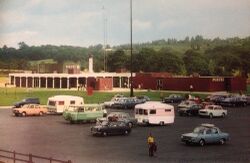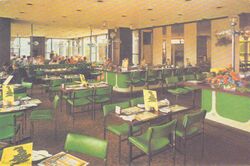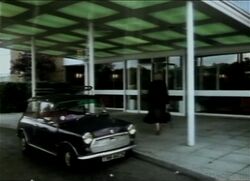History of London Gateway (Scratchwood) services
< return to London Gateway (Scratchwood) services

The services in its original colour scheme.

The need for London Gateway (originally Scratchwood services) was first established in 1961, when Redbourn was unable to be built but some additional capacity was needed.
There were no suitable sites anywhere to be found on the existing M1, save for a stop-gap solution at Toddington, so attention turned to the M1's southern extension (J1-5) that hadn't yet been built. Other options at Beechtree, immediately south of J8, and at M1 J6 were looked at.
Scratchwood's full history is outlined here.
Location and Junction
As the M1 extension came closer to being built, it was noted that the new road required its own maintenance compound and service station. However the new motorway offered very little space for any additional facilities; a search which was hampered by closely-spaced junctions and the parallel railway line.
Originally, the M1 was to have a J3, the Scratchwood Interchange, which would have flowed freely on to the Stirling Corner Link Road, providing access to the A1 and A41. An opportunity was spotted to build a maintenance compound on the west side of the interchange which was right in the centre of the new section of the M1; this could serve two other important roads too. This was particularly appealing as Barnet Borough Council had lost one of their depots to the new road, and were looking for a new one. Building the depot required the complex plan for Scratchwood Interchange to be scrapped and replaced with a simple roundabout.
Only once this had become the preferred design was it realised that the land west of this roundabout would also make a good site for a service station. Before the service area could be added to the mix, the land had to be reclaimed from British Rail, where it was being occupied by the disused Scratchwood sidings. The service area could then be squashed between the M1 and the Midland Mainline. You can see the intended layout on SABRE Maps.
In the event, the Stirling Corner Link Road was postponed and eventually cancelled, and further damage to the east side of the roundabout was never repaired. As a result access to the service area is provided by a very odd reversed roundabout arrangement with sharp corners and a strange crossover. An upgraded rear access provided access to the local road network for maintenance vehicles.
The Bartlett Review had recently concluded that service areas at the end of the motorway receive more custom. This would turn out to be a mistake, but at the time it made Scratchwood look like a prestigious site and one worth investing in.
Until the completion of the M25 in 1986, Scratchwood services was regularly at full capacity. Since then, it has become one of the quieter service areas.
Planning and Opening
Industry assessment, 1978
Various catering and hospitality firms were invited to design the service area. Struggling Top Rank were one of few to decline the offer.
The top bid for the service area came from a firm called Grand Metropolitan Motorway Services, with Fortes coming second. Grand Metropolitan had Granada directors on board and were a sister company to Grand Metropolitan Hotels.
The Ministry decided to discount Grand Metropolitan's bid because Granada had made significant errors at Heston. Meanwhile, Granada objected to Scratchwood as their Toddington was already making a loss. Fortes' building was better but had poor landscaping. Another firm, AVP Industries Ltd, designed a proposal but with very poor finances.
Scratchwood services opened in 1969. Fortes were unable to access the site until six months after they'd been told they could, as the land was being used to store motorway materials.
The Ministry made the unusual decision to provide high mast lighting around the M1 junction here. They provided the same columns around the service area, and a row of them straddled the two. This made sense when the Ministry of Transport owned all the motorway service areas, but after they were sold off in the 1990s, you now have the odd situation where the motorway's lights are lighting up somebody else's car park.
Design

As would be expected of a site crammed into a suburban area, the service area has a single, simple, low, box-shaped amenity building. The architect was Garnett Cloughley Blakemore and Associates, who wanted to keep the restaurant hidden away from both the road and the neighbouring community.
Originally there was a garden in a courtyard at the centre of the service area and while the garden was removed in the 1990s, its location can still be made out by looking at the atrium roof. It had a light café, with large windows, green chairs and bronze tinted windows. Scratchwood also had the country's first AA customer kiosk.
The grill restaurant was soon replaced by a standard café. A Julie's Pantry was added in 1982, with the small shop being the other main facility. A coffee shop was added, which had exposed brickwork. Much of the building hasn't been extended, but the large restaurant has been replaced by more fast food facilities.
A government review described the facilities as "too crowded". In 1977 Egon Ronay rated the service area as "poor", complaining about its worn appearance, dirty floor, slow service and lack of choice on the menu. The Chef's Steak cost £2.95 (around £17 in 2025), but otherwise it was mostly convenience food. He regarded it as Welcome Break's "forgotten zone" following his 1989 visit, calling it "austere and utilitarian". Overnight HGV parking cost £3.50 in 1990, which is worth around £8 in 2025.
The service area was originally used to trial a home-grocery service. Almost 50 years later this came back as Waitrose.
These days, the use of spread out, low-density buildings looks strange in such a high-demand urban area. The expected high levels of HGVs and coaches didn't materialise, and the cars which do visit tend to be stopping for a snack rather than a full meal. All of this means the land is not being used very efficiently. Welcome Break intends to change this.
Hotel

The hotel at London Gateway opened in around 1972 as the Scratchwood Excelsior Motor Lodge. It was styled to look like an American motel, and was soon branded TraveLodge Motor Lodge.
The hotel was positioned down Scratchwood's rear access. The Department of Environment agreed to lift restrictions on part of the road, and to declare the hotel as being separate from the service area, which allowed it to serve alcohol. They considered this to be an experiment. Abuse of the emergency exit was especially bad at Scratchwood, where there is a large local population, despite many attempts to control it with different barriers and signs.
Given its outdated style, the hotel was relegated from Travelodge to Forte's budget name Welcome Lodge. By this stage it had 100 rooms.
The hotel was demolished and replaced by a newer building in 1999, which branded as one of the UK's first Days Inn hotels. This happened at around the same time as the name of the service area itself was rebranded to the more marketable London Gateway.
The hotel later moved to the more premier Days Hotel brands, and then one of Welcome Break's first Ramadas.
Events
The building was evacuated on 20 June 1989, after a call was made claiming a bomb was on the premises. The threat turned out to be untrue. Service areas are busy transport hubs and had to be on high alert during this difficult period.
The service area's car park formed the start of an out-of-London challenge during a 2009 episode of The Apprentice. The name 'London Gateway' confused the participants, who thought they were heading to an upmarket hotel.
On the weekend of 16 April 2011, the M1 between J1 and J4 was closed following for several days following a severe fire at a scrapyard next to the service area. London Gateway was expecting a lot of custom with several events taking place in London, but instead there were no customers and staff were sent up to South Mimms instead. Hotel bookings were cancelled and fresh food had to be thrown out.
< return to main page (London Gateway (Scratchwood) services)